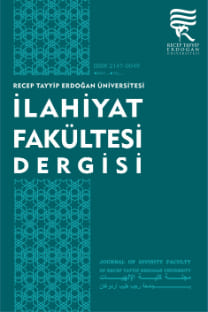Kullanımı Haram veya Şüpheli Olan Altınların Hukuki İşlemlere Konu Edilmesi
Kıymetli bir maden olan altın, geçmişte ve günümüzde birçok amaçla kullanılmıştır. Çoğunlukla süs eşyası olarak kullanılan altın, aynı zamanda piyasada tedavül eden para, hastalıkların tedavi ve teşhisinde tıbbî malzeme ve sanayide teknik malzeme olarak kullanılmaktadır. Çalışmamızda kullanılması haram yahut şüpheli olan altından üretilmiş süs eşyalarının hukuki işlemlere konu olması ele alınmış, diğer konulardan bahsedilmemiştir. Bu çerçevede yüzük, küpe, bileklik, rozet, kravat iğnesi vb. birçok erkek ziynet eşyaları; tabak, çatal, kaşık, bıçak gibi ev eşyaları; haç, heykel, nazar boncuğu gibi ikonların İslam borçlar hukuku kapsamında üretilmesi ve satılması konuları ele alınmıştır. Tabiatıyla bu gibi eşyaların kullanımı ile ilgili beyan edilen hükümler, bunların hukuki işlemlere konu edilmeleriyle ilgili hükümlere etki etmektedir. Nitekim fakihlerin borçlar hukukundaki ictihadları, bu tür ziynet eşyalarının kullanımıyla ilgili paradigmaları çerçevesinde şekillenmiştir. Dolayısıyla bu çalışmada borçlar hukukunu ilgilendirdiği ölçüde altından üretilmiş eşyaların kullanımı konularına değinilmiştir.
Anahtar Kelimeler:
borçlar hukuku, kuyumcu, altın, ziynet, ikon
Subjecting Gold -that are Undemanding or Suspect to Use- to Legal Transactions
Gold, a precious metal, has been used for many purposes in the past and present. Gold, which is mostly used as ornaments, is also used as money in circulation on the market, as a medical material in the treatment and diagnosis of diseases and as a technical material in the industry. In our study, the use of ornaments made of gold, which is forbidden or suspicious, is the subject of legal proceedings, and other instruments are not mentioned. In this frame, the production and sale of rings, earrings, bracelets, rosettes, tie pins, etc. many men's jewelery; household items such as plates, cutlery; icons such as cross, sculpture and evil eye beads are discussed within the scope of Islamic debt law. Naturally, the declared provisions regarding the use of such articles affect their provisions when they are subject to legal proceedings. As a matter of fact, the jurisprudence of the jurisprudents in the law of obligations was shaped within the framework of their paradigm regarding the use of such jewelery. Therefore, in this study, the use of goods produced from gold has been addressed to the extent that it concerns the law of obligations.
Keywords:
Law of Obligations, Jewelery, Gold, Trinket, Icon,
___
- Adevî, Ebü’l-Hasen Alî b. Ahmed b. Mükremillâh (Mükerrem) es-Saîdî. Hâşiyetü’l-Adevî ‘alâ şerhi Kifâyeti’t-tâlibi’r-rabbânî. Beyrut, 1994.
- Ahmed b. Hanbel. Müsned. thk. Şuayb el-Arnaût, Âdil Mürşid ve diğerleri. Müessesetü’r-Risâle, 1. Basım, 1421.
- Asutay, Hasip. Fıkıhla İlgili İlginç Sorular ve Cevapları. İstanbul, 2015.
- Aynî, Ebû Muhammed Bedreddin Mahmûd b. Ahmed b. Musa Hanefi. Umdetü’l-kârî şerhu sahîhi’l-Buhârî. Beyrut: Dâru İhyâi’t-Türâsi’l-Arabî, ts.
- Bâbertî, Ekmelüddîn Muhammed b. Mahmud. Şerhu’l-İnâye ale’l-Hidâye. 10 Cilt. Dımaşk: Darü’l-Fikr, ts.
- Yayın Aralığı: Yılda 2 Sayı
- Yayıncı: Recep Tayyip Erdoğan Üniversitesi İlahiyat Fakültesi
Sayıdaki Diğer Makaleler
Muhammed Ebû Zehre’ye Göre Kur'an'ın Teğannî İle Okunuşu
İbn Ammâr’ın Hayatı, Siyasî Kişiliği ve Haçlılara Karşı Mücadelesi
Erdem ALADA, Recep ERKOCAASLAN
Erzurumlu Göğsügür Lütfullah Efendi ve Tahrîr fî Fenni Mustalahi’l-Hadis Adlı Risalesi
Kur’an’ın Kur’an’la Tefsiri Bağlamında Nisa Suresi 34. Âyetinin Tahlil ve Değerlendirmesi
Kullanımı Haram veya Şüpheli Olan Altınların Hukuki İşlemlere Konu Edilmesi
Kur’an’da Peygamberler Örnekliğinde Ailede Anne-Baba ve Çocukların Hukuku
Ebü’l-Leys es-Semerkandî'nin Tefsirinde Kıraatlere Yaklaşımı
Muhammed Esed’in “Kur’an Mesajı Meal-Tefsir”inde Fitne Kavramına Yaklaşımı
